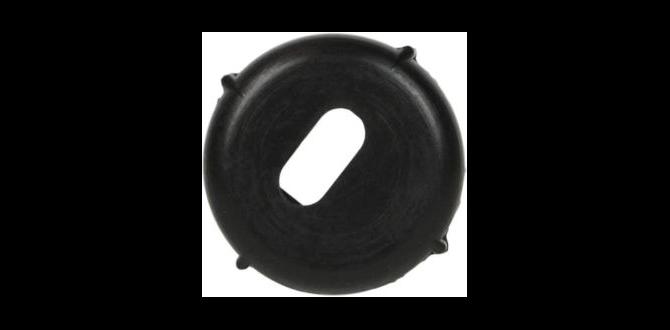Quick Summary:
Nail gun pressure loss is often caused by air leaks, low compressor pressure, or a dirty tool. Fixing these issues involves checking O-rings, seals, and hoses, ensuring your air compressor is correctly set, and performing regular maintenance on your nail gun. We’ll guide you through diagnosing and solving these common problems to get your nailer firing powerfully again.
Hey there, fellow builders and DIY enthusiasts! Jack Shaffer here from Nailerguy. Ever been right in the middle of a project, ready to drive that perfect nail, only to have your nail gun sputter and lose its punch? It’s incredibly frustrating, right? That sudden drop in power can halt your progress and leave you scratching your head. But don’t worry, it’s a surprisingly common issue, and usually, it’s something you can fix yourself with a little know-how. We’re going to break down exactly what causes this pressure loss and, more importantly, give you proven solutions to get your nail gun back in top working order, so you can get back to building with confidence!
Table of Contents
Understanding Your Nail Gun’s Power Source
Before we dive into the problems, let’s quickly chat about how your nail gun gets its power. Most common nail guns, especially pneumatic ones, rely on compressed air. An air compressor stores air under pressure, and when you pull the trigger, a quick burst of this air is released to drive the piston and, consequently, the nail. Think of it like a tiny, controlled explosion fueling each nail drive.
The amount of air pressure is crucial. Too little, and the nail won’t drive fully. Too much, and you risk damaging your workpiece or even the tool. Maintaining the correct and consistent pressure is key to efficient and effective nail gun operation. When you experience pressure loss, it means something is preventing that smooth, powerful delivery of compressed air.
Common Culprits Behind Nail Gun Pressure Loss
When your nail gun starts acting weak, it’s usually down to one of a few things. Identifying the cause is the first step to a quick fix. Let’s look at the most frequent offenders.
1. Air Leaks: The Silent Energy Drain
This is the #1 reason for pressure loss. Even a tiny leak can significantly reduce the air reaching the piston. Think of it like trying to fill a bucket with small holes in it – the water (air) just keeps escaping.
- Hoses and Couplings: The air hose connecting your compressor to the nail gun is a prime spot for leaks. Check for cracks, kinks, or holes in the hose itself. The quick-connect fittings where the hose attaches to the compressor and the nail gun also need a good seal. If these aren’t tight or the O-rings inside are worn, air will escape.
- Internal Seals and O-rings: Inside your nail gun is a series of seals and O-rings that keep the compressed air contained and directed where it needs to go. Over time, these can wear out, crack, or become brittle, especially with heavy use or exposure to certain lubricants. A leaky piston seal or valve seal is a common internal culprit.
- The Nailer’s Casing: While less common, sometimes a hairline crack in the tool’s body or a poorly seated component can allow air to escape.
2. Insufficient Air Compressor Pressure
Your nail gun is only as powerful as the air you feed it. If your air compressor isn’t producing enough pressure, your nailer will naturally suffer.
- Incorrect Regulator Setting: The regulator on your air compressor controls the output pressure. It might simply be set too low for the demands of your nail gun. Most framing nailers, for example, require around 70-120 PSI.
- Compressor Struggling to Keep Up: If you’re firing the nail gun rapidly, the compressor might not be able to replenish the air fast enough. You might hear the compressor cutting in and out more frequently, or it might be a smaller compressor not designed for continuous high-demand use.
- Altitude or Environmental Factors: While less common for typical DIY use, extreme altitudes can affect air pressure.
3. A Dirty or Clogged Nail Gun
Tools need maintenance! When your nail gun gets dirty, its internal mechanisms can become sluggish, leading to pressure issues.
- Clogged Air Inlet: Debris can enter the air inlet valve and obstruct airflow.
- Gummed-up Internal Parts: Old oil, dust, and residue can build up inside the tool, particularly around the piston and cylinder. This friction and blockage can impede the smooth movement of parts, requiring more air pressure to overcome.
- Dirt on Trigger Valve or Driver Blade Mechanism: Any part of the air delivery system that gets clogged can reduce efficiency.
4. Tool Damage or Wear
Like any tool, nail guns wear down over time, and sometimes they can get damaged.
- Worn Piston and Cylinder: The piston moves rapidly within the cylinder. Over time, friction can cause wear, creating small gaps where air can leak, reducing driving force.
- Damaged Driver Blade: A bent or nicked driver blade can affect how it engages the nail head and how the air is delivered, potentially leading to less efficient firing.
- Internal Spring Issues: Some internal springs can weaken or break, affecting the tool’s cycling and air management.
Proven Solutions for Nail Gun Pressure Loss
Now that we’ve identified the common problems, let’s get them fixed! These solutions are designed to be straightforward and effective for beginners.
Step 1: The Quick Air Leak Check (The “Spray Test”)
This is your first line of defense. You’re listening and feeling for escaping air.
- Connect Everything: Hook up your air hose to the compressor and the nail gun.
- Pressurize the System: Turn on your compressor and let it build up to its set pressure. For this test, it’s good to have it at the higher end of your typical operating range, but within the safe limits for your nailer (usually printed on the tool).
- Listen Carefully: With no trigger pull, slowly move the nail gun’s nose around. Listen for any hissing sounds.
- Feel for Air: Gently run your hand (carefully!) around all connection points:
- Where the hose connects to the compressor.
- Where the hose connects to the nail gun.
- Around the nail gun’s nose piece.
- Around any seams or other fittings on the nail gun itself.
- Use Soapy Water (Optional but Recommended): For a more thorough check, mix some dish soap and water in a spray bottle. Spray it on all the connection points and areas where you suspect a leak. Any escaping air will create small bubbles, making the leak very visible.
Step 2: Addressing Hose and Coupling Leaks
If your spray test revealed leaks at the hose or couplings, here’s how to fix them:
Common Issues and Fixes for Hoses and Couplings
Don’t underestimate the power of a good seal! These are often the easiest and most cost-effective fixes.
| Problem Area | Symptom | Solution |
|---|---|---|
| Hose: Cracks/Holes | Hissing sound, visible damage, bubbles when sprayed with soapy water. | Replace the damaged section of the hose or the entire hose if the damage is extensive or in multiple places. Ensure the replacement hose is rated for the PSI your tools require. For a quick fix on a very small puncture, some automotive repair tape might work temporarily, but a full replacement is always best for reliability. |
| Coupling: Loose Connection | Hissing sound, air blowing out from the connection point. | Tighten the fitting by hand. If it still leaks, try wrapping Teflon tape (plumber’s tape) around the threads of the fitting before screwing it into the nail gun or compressor. Ensure the tape is applied in a clockwise direction. |
| Coupling: Worn O-ring | Hissing sound from the male end of the coupling or the female receptacle, especially when connected. | Disconnect the hose. The O-ring is usually a small rubber ring inside the female coupling (the part on the compressor or nail gun) or sometimes on the male end (the part attached to the hose). Carefully remove the old O-ring with a small pick or flathead screwdriver. Bring the old O-ring to a hardware store to find an exact match in size and hardness. Install the new O-ring, ensuring it sits correctly. You can apply a tiny bit of silicone grease to the O-ring to help it seal and last longer. |
| Coupling: Damaged Threads | Leak at the connection point, difficulty screwing the fitting on. | Inspect the threads on both the hose fitting and the receptacle. If they are damaged (bent, stripped), the fitting or receptacle may need to be replaced. This can be a more involved repair, especially if on the compressor itself. |
Step 3: Checking and Adjusting Air Compressor Pressure
“Okay, Jack, my hoses and connections seem fine. What’s next?”
Your next step is to ensure your air compressor is delivering the right amount of air. This is all about the regulator.
- Locate the Regulator and Gauge: Most air compressors have a dial or knob near the air outlet that controls pressure, along with a gauge showing the current output.
- Consult Your Nail Gun’s Manual: This is vital! Your nail gun’s manufacturer will specify the ideal operating pressure range (often in PSI – Pounds per Square Inch). You can usually find this on the tool itself, in its manual, or on the manufacturer’s website. For example, 15-gauge finish nailers might run at 70-100 PSI, while framing nailers could require 90-120 PSI.
- Set the Regulator: With the compressor running and the nail gun attached (but not firing), slowly turn the regulator knob. Increase the pressure until it’s within the recommended range for your specific nail gun. Most regulators are adjusted by pulling out a knob, turning it, and then pushing it back in.
- Test Fire: While keeping an eye on the compressor’s tank pressure (the other gauge), fire a few test nails into scrap wood. Did the power improve?
- Watch the Compressor’s Duty Cycle: If you’re firing nails very rapidly, even with the correct pressure, a small compressor might struggle to keep up. You might notice the tank pressure dropping significantly between nail drives, or the compressor motor running almost constantly. If this is the case, you might need to slow down your rate of fire, take breaks to allow the compressor to catch up, or consider upgrading to a larger compressor for heavier-duty tasks. For more information on compressor sizing, the U.S. Department of Energy offers guidance on energy efficiency that can indirectly help in tool selection regarding air delivery: Compressed Air Systems – U.S. Department of Energy.
Step 4: Cleaning and Lubricating Your Nail Gun
A clean tool is a happy tool, and a happy tool performs! Regular cleaning and lubrication are key to preventing internal issues.
DIY Nail Gun Maintenance Checklist
This process will vary slightly depending on your nail gun model, so it’s always best to consult your owner’s manual. However, here’s a general guide.
- Safety First: Disconnect Air! ALWAYS disconnect the air supply from your nail gun before performing any maintenance.
- Empty the Nail Magazine: Remove all nails from the feeder.
- Clean the Exterior: Wipe down the tool with a damp cloth. Remove any dust, sawdust, or debris from the body, especially around air inlets and moving parts.
- Clean the Air Inlet: Use a small brush or compressed air (from a separate source, not your nailer!) to clear any debris from the air inlet valve.
- Clean the Nose Piece/Contact Trip: Sometimes sawdust can get lodged around the nose piece or the contact trip (the part you press against the wood to fire). Carefully clean this area with a brush or a soft cloth.
- Lubrication: This is crucial for pneumatic tools.
- Apply Air Tool Oil: Most pneumatic nail guns require a few drops of specialized air tool oil. This oil is usually added through the air inlet. Put 2-3 drops into the air inlet port.
- Cycle the Tool: Reconnect the air supply briefly. Fire the tool several times into scrap wood to distribute the oil throughout the internal mechanisms, especially the piston and cylinder.
- Disconnect Air Again: Disconnect the air supply once more.
- Fire into the Air (Carefully): Hold the nailer pointing away from yourself and others into the air, and pull the trigger a few times. This helps to blow out any excess oil and residual debris.
- Check Driver Blade: Some nail guns allow for easy access to the driver blade. If yours does, check it for any damage or bending. If it’s damaged, it might need professional repair or replacement.
- Clean Firing Mechanism (Advanced): For some tools, you might be able to access and clean the firing mechanism more thoroughly. Again, refer to your manual. This often involves removing a few screws and carefully cleaning small parts. Be sure to reassemble them in the correct order!
How often should you lubricate? For frequent use, a few drops of air tool oil after every few hours of operation or at the end of each workday is a good rule of thumb. For less frequent use, lubricate before each project. This prevents internal components from drying out and seizing.
Step 5: Inspecting Internal Seals and Wearing Parts
If the spray test and cleaning didn’t solve the problem, it’s time to look at the internal components. This is where you might need a repair kit.
Many nail gun manufacturers offer repair kits specifically for their models. These kits typically contain replacement O-rings, seals, and sometimes even springs or small replacement parts for the internal mechanism.
When to Consider Internal Seal Replacement:
- You hear air escaping directly from the tool body, not just connections.
- The tool feels weak and sluggish even after thorough cleaning and lubrication.
- The tool starts leaking air from the exhaust port even when not firing.
The Process (General):
- Safety First: Disconnect Air! You know the drill!
- Get the Right Kit: Ensure you have the correct repair kit for your specific nail gun model.
- Consult Your Manual: This is CRITICAL. Nail guns have intricate internal parts. Your manual will show you exactly how to disassemble and reassemble your tool.
- Disassemble Carefully: Take photos as you go or lay parts out in order on a clean surface.
- Replace Worn Seals: Identify the old, worn O-rings and seals. Carefully remove them and install the new ones from the kit. Pay close attention to the orientation and placement of each seal.
- Check Other Parts: While disassembled, inspect the piston, driver blade, and cylinder for any obvious damage, scoring, or excessive wear.
- Lubricate: Apply a light coat of air tool oil or silicone grease to new O-rings and seals before reassembly.
- Reassemble: Put the tool back together, making sure all screws are snug but not overtightened.
- Test: Reconnect the air and test fire.
If you’re not comfortable with this level of disassembly, it’s often best to take your nail gun to a tool repair shop. A professional can diagnose and fix internal issues quickly and accurately.
Step 6: Checking for Tool Damage
Sometimes, the pressure loss isn’t due to wear, but damage from a drop or misuse.
- Inspect the Body: Look for any cracks, large dents, or bent parts, especially around the magazine and firing mechanism.
- Check the Magazine: Ensure the nail magazine slides smoothly and isn’t bent or damaged, as this can affect nail feeding and air sealing.
- Driver Blade: If you can easily access it (refer to your manual), check the driver blade for bends, nicks, or damage. A damaged driver blade can impede air flow and cause firing issues.
If you find significant damage, especially to the main body or internal components that cannot be easily replaced with a kit, it might be more cost-effective in the long run to replace the nail gun. For a beginner’s perspective on choosing reliable tools, this guide from Popular Mechanics can offer



